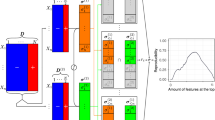Abstract
Ranked models in the form of linear transformations of multivariate feature vectors on a line can be found on the basis of a priori given order within particular pairs of objects or events. Such ranked transformations are designed to preserve given sequential order. In this way, the sequential patterns inside sets of the feature vectors can be discovered and modelled. Attention is paid here to combining problems of sequential patterns modelling and recognition with feature selection. The feature selection problem is aimed at the best representation of the sequential patterns. The convex and piecewise linear (CPL) criterion functions are used here both for designing ranked linear models and for feature selection.
Similar content being viewed by others
References
Duda OR, Hart PE, Stork DG (2001) Pattern classification. Wiley, New York
Fukunaga K (1972) Introduction to statistical pattern recognition. Academic Press, London
Johnson RA, Wichern DW (1991) Applied multivariate statistical analysis. Prentice-Hall, Englewood Cliffs
Bobrowski L (2005) Ranked modelling with feature selection based on the CPL criterion functions. In: Perner P, et al. (eds.) Machine learning and data mining in pattern recognition. Lecture notes in computer science, vol. 3587. Springer, Berlin
Bobrowski L (1991) Design of piecewise linear classifiers from formal neurons by some basis exchange technique. Pattern Recognit 24(9):863–870
Simonnard M (1966) Linear programming. Prentice-Hall, Englewood Cliffs
Vapnik VN (1998) Statistical learning theory. Wiley, New York
Klein JP, Moeschberger ML (1997) Survival analysis techniques for censored and truncated data. Springer, New York
Bobrowski L, Łukaszuk T (2005) Ranked linear modeling in survival analysis. In: Bobrowski L, Doroszewski J, Victor N (eds) Lecture notes of the ICB seminars: statistics and clinical practice. IBIB PAN, Warsaw, pp. 61–67
Author information
Authors and Affiliations
Corresponding author
Additional information
This work was partially supported by the grants KBN 3T11F011 30, by the grant W/WI/1/2007from the Białystok University of Technology and by the grant 16/St/2007 from the Institute of Biocybernetics and Biomedical Engineering PAS.
Rights and permissions
About this article
Cite this article
Bobrowski, L. Ranked linear models and sequential patterns recognition. Pattern Anal Applic 12, 1–7 (2009). https://doi.org/10.1007/s10044-007-0092-8
Received:
Accepted:
Published:
Issue Date:
DOI: https://doi.org/10.1007/s10044-007-0092-8



